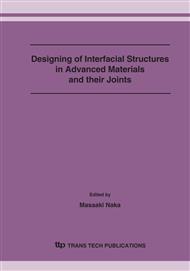p.259
p.265
p.271
p.277
p.283
p.289
p.295
p.301
p.307
Evaluation of Compound Layer Formed by Impact Welding Using Phase Transformation Technique
Abstract:
When a cylindrical projectile is impact-welded to a flat target, a compound layer is usually observed at the joining interface as a result of the impact welding. In this study, the formation process of the compound layer was formulated as a moving boundary problem, which is a phase transformation technique. The numerical results were compared with the experiment results obtained using an aluminum projectile and stainless steel target. Numerical analysis shows that the melting area is similar to the temperature profile given at the boundary face. The area of the compound layer formed at the joining interface almost agrees with the melting area of the target. The profile of the compound layer is similar to the triangular temperature profile in the given temperature profiles. The mixing ratio of the melting weights of aluminum and stainless steel obtained by the numerical analysis strongly depends on the temperature rise at the interface. The melted weight of aluminum in the experiment is somewhat greater than that in the numerical analysis. The heat conduction analysis including deformation of the projectile and target make the results of the numerical analysis closer to the experimental results.
Info:
Periodical:
Pages:
283-288
Citation:
Online since:
September 2007
Authors:
Price:
Сopyright:
© 2007 Trans Tech Publications Ltd. All Rights Reserved
Share:
Citation:


